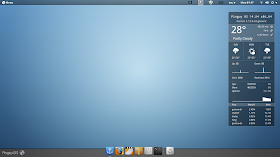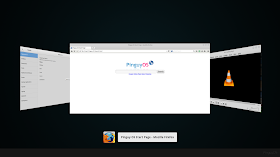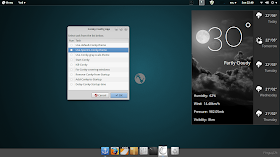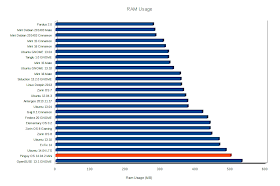With the release of Ubuntu Trusty, I am expecting plenty of Ubuntu based spins to come out in the next couple of months. One of the first spins to release is that of Pinguy OS, an established name among the Linux beginners. Pinguy's beauty is that they provide an easy to use and stylish operating system which works without requiring much tweaking from the user. I was impressed with the design and aesthetics of the Ubuntu Precise based Pinguy OS 12.04 release and hence, decided to try out the Trusty spin as well.
Score for Hardware Recognition: 7.5/10
I downloaded the 64-bit Pinguy OS 14.04.2 release from sourceforge. Though it's name suggests "Mini" but the ISO is about 1.6 GB in size. It is an unusually large ISO for a stripped down version, I must say. The release notes states of a whole of add-ins over Ubuntu GNOME version. I'll discuss the important features in the subsequent sections.
Like Ubuntu Trusty, Pinguy OS ships with a tweaked GNOME 3.10 desktop and Linux kernel 3.13.0. I created a live USB using Linux Mint Image writer on a 4 GB pendrive and installed it on the Asus K55VM laptop with 2.3 Ghz Core i7 processor, 8 GB DDR3 RAM and 2 GB NVIDIA GeForce graphics. Though the below screenshot show Pinguy as Ubuntu 13.10 but in reality it is Ubuntu Trusty. I understand it is Ubuntu's fault but, a rebranding to Pinguy OS 14.04 would have done better.
Installation
Installation is plain vanilla Ubuntu process and no surprises there. It took me 15 minutes to install Pinguy on a 50 GB partition. However, post installation, I ran into an issue with graphic card drivers, as discussed next.
Post-installation Complications due to Hybrid Graphics
Though the live USB booted up nicely and allowed me to install, I couldn't boot the installed distro initially. It happened due to hybrid graphics in my laptop and presence of nvidia-prime in Pinguy OS by default. Nvidia-prime works with lightdm and has issues with gdm (the default display manager in gnome distros). It took me black screen of death every time.
Hence, I went to recovery mode and selected "Root" to drop to root shell prompt. As it is in recovery mode, the file systems are mounted as read only. I mounted the file system to read-write mode by running the command:
$ sudo mount / -o remount,rw
Now I removed all nvidia packages by:
$ sudo apt-get purge nvidia*
About 200 MB of packages got removed. Once done, I rebooted and this time it worked. I was greeted with a beautiful Pinguy OS desktop environment. Later I installed bumblebee to reduce laptop heat and use Nvidia graphics only when required. I wonder why at all Nvidia-prime is there in Pinguy OS when it doesn't work with gdm.
Hardware Recognition and the Dual Monitor bug
Pinguy OS, apart from the graphic card piece, worked perfect recognizing my screen resolution, wifi, lan, touch pad and sound card. Everything worked as expected. However, there is a dual-monitor bug in Pinguy OS. Like Ubuntu Trusy, Pinguy too initially display a VGA 1024*768 monitor along with the default one. Once I deselect it in Ubuntu (from System Settings -> Display), it turns off to never reappear again. But, in Pinguy OS, the dual monitor bug comes back on every reboot! It was a really clumsy experience to turn it off every time for me as an user.
Score for Hardware Recognition: 7.5/10
Aesthetics
Pinguy OS 14.04 has an almost similar interface as Pinguy OS 12.04. It has the same bottom and left side docky with a conky at the right side. One major change is in the wallpapers - now they are simpler with Pinguy OS labelled at the bottom. The bottom of the wallpaper appears like a panel and adds glamour to the distro.
Pinguy OS ships with some monochrome wallpapers (similar to the default one) with Pinguy OS labelled at the bottom. They are available in the /home/Pictures directory.
Pinguy OS has subtle animations and would appeal to regular users. Windows + Tab creates really nice switch window effect. Plus, all the GNOME 3 shortcuts work with Pinguy OS as well.
Pinguy OS ships with a package Conky - it is not as versatile as conky manager but provides a couple of alternatives for desktop decoration with conkies. The weather conky looks pretty awesome.
Unlike Ubuntu GNOME or Ubuntu itself, Pinguy OS ships with whisker menu and not a dash. It works for me better than dash.
Gnome tweaks is present in the distro to tweak the appearance as per user's preference.
Except for the Ubuntu 13.10 branding and dual monitor issue, Pinguy OS is aesthetically quite appealing and presents a good alternative to those who hate Ubuntu and things wrong with GNOME 3.
Score for aesthetics: 10/10
Packages and Repositories
Pinguy OS 14.04 has an almost similar interface as Pinguy OS 12.04. It has the same bottom and left side docky with a conky at the right side. One major change is in the wallpapers - now they are simpler with Pinguy OS labelled at the bottom. The bottom of the wallpaper appears like a panel and adds glamour to the distro.
 |
| From Pinguy OS 14.04.2 Mini http://mylinuxexplore.blogspot.in |
 |
| From Pinguy OS 14.04.2 Mini http://mylinuxexplore.blogspot.in |
 |
| From Pinguy OS 14.04.2 Mini http://mylinuxexplore.blogspot.in |
 |
| From Pinguy OS 14.04.2 Mini http://mylinuxexplore.blogspot.in |
 |
| From Pinguy OS 14.04.2 Mini http://mylinuxexplore.blogspot.in |
 |
| From Pinguy OS 14.04.2 Mini http://mylinuxexplore.blogspot.in |
Score for aesthetics: 10/10
Packages and Repositories
I take a different evaluation process for Pinguy OS, as it is on surface thin in pre-installed packages but ships with an enviable collection of package sources which I've rarely seen in any Ubuntu spin. Pinguy provides almost a clean slate for power users to install their preferred applications. A list of the limited pre-installed packages is given below:
- Office: Document viewer
- Internet: Firefox 29.0, Teamviewer 9
- Graphics: Image viewer, Simple Scan
- Multimedia: File bot, VLC 2.1.5 media player
- Accessories: Backups, Docky, Fuiles, gedit, Menu editor, Gnome Do, Conky, GDebi package installer, Gparted, Nepomuk cleaner, Tweak tool, UXterm, Xterm, Terminal, Archive Manager, Calculator
- Others: Unetbootin, Remastersys
Superficially the application section seems a bit thin. However, Pinguy OS mini ships with a whole lot of nuts and bolts pre-installed. Take the example of Firefox: it has almost all the plugins and extensions I could think of like Netflix, Flash, Quicktime, Divx, Java, Hangouts etc. eerflix and the Firefox scripts (which allow you to click a torrent in Firefox and start playing it immediately using VLC) are available by default.
Further, it has some interesting new applications:
Another important change is that TRIM is now used by default. TRIM allows the OS to “inform a solid-state drive (SSD) which blocks of data are no longer considered in use and can be wiped internally”. Without using TRIM, the SSD speed decreases after a while so if you have a solid-state drive that supports TRIM, you should enable it so your SSD remains fast over time. However, I didn't have an SSD and hence, couldn't check it.
Pinguy OS 14.04.2 Mini ships with a host of 3rd party ppa's added to the distro in addition to Ubuntu and Linux Mint repository links. A glimpse of the same is shown below.
Pinguy has Ubuntu Software Center as the default GUI to browse and install packages. As a result of the addition of external ppa's, applications like Spotify, Google Chrome, Skype, etc. are available in the repository out-of-the box. This is a great enhancement for Linux novices, saving them precious time.
Synaptic Package Manager is also present in Pinguy along with Y PPA Manager. Y PPA Manager provides an easy way to add PPA's of external repositories for users who are not comfortable with terminal.
Gtkorphan is another package I liked. It removes the orphaned packages and ensures that the system is clean.
Some nice features like CPU temperature in the terminal, etc. are present in Pinguy. The temperature recorded here is high as NVIDIA graphics were on.
All in all, Pinguy OS 14.04.2 provides a basic operating system with all necessary ingredients. Users who prefer to select and install their own choice of applications will enjoy using Pinguy OS.
Score for Packages and Repositories: 10/10
Performance
Maybe because of all the tweaks, I didn't get the performance I expected from a stripped down distro. Pinguy Mini felt a little heavy, in fact heavier than Ubuntu GNOME. At steady state with system monitor running, Pinguy OS consumed about 500 MB RAM. It has about 30% more RAM consumption than average RAM consumption (387 MB) of 64-bit GNOME/ GNOME forked distros.
Further, the boot up time with autologin enabled is one of the worst I've seen in GNOME / GNOME forked distros. Pinguy OS takes about 65 seconds to boot which is 57% higher than average (41 sec) on the same laptop.
Possible explanation of reduction in performance may be the tweaks in Pinguy OS. However, on a powerful system, you won't even feel the difference. The system never hanged on my laptop. However, on a medium powered machine, you may feel the difference. I won't even advocate using Pinguy OS if the RAM is less than 2 GB and the CPU is not dual core at minimum.
Score for Performance: 4.5/10
Overall
Pinguy OS 14.04.2 Mini is a good attempt at providing a basic distro on which users can add their preferred packages. I like it's approach and would've considered using it for production purposes had there not been bugs like dual monitors being detected at every boot or bugged by poor performance. Packages like system monitor doesn't open even when clicked. Also, the present configurations don't work well for computers with NVIDIA graphics. I am expecting a better release in the full version - it is in RC stage at the moment. The mini release seems to be a bit rushed out and is a bit buggy.
For the mini version, I am going with a score of 7.9/10. You can download the 32 and 64 bit mini versions from here.
Overall Score: 7.9/10
Breakup
Installation (20% weight): 8.5/10
Aesthetics (20% weight): 10/10
Hardware Recognition (20% weight): 7.5/10
Packages and Repositories (10% weight): 10/10
Performance (30% weight): 4.5/10
 |
| From Pinguy OS 14.04.2 Mini http://mylinuxexplore.blogspot.in |
- FileBot, an application that allows you to batch rename Movie and TV Show files;
- GNOME Do (quick launcher);
- A data recovery script that uses TestDisk is also available by default with Pinguy OS 14.04 Mini.
Another important change is that TRIM is now used by default. TRIM allows the OS to “inform a solid-state drive (SSD) which blocks of data are no longer considered in use and can be wiped internally”. Without using TRIM, the SSD speed decreases after a while so if you have a solid-state drive that supports TRIM, you should enable it so your SSD remains fast over time. However, I didn't have an SSD and hence, couldn't check it.
Pinguy OS 14.04.2 Mini ships with a host of 3rd party ppa's added to the distro in addition to Ubuntu and Linux Mint repository links. A glimpse of the same is shown below.
 |
| From Pinguy OS 14.04.2 Mini http://mylinuxexplore.blogspot.in |
 |
| From Pinguy OS 14.04.2 Mini http://mylinuxexplore.blogspot.in |
 |
| From Pinguy OS 14.04.2 Mini http://mylinuxexplore.blogspot.in |
 |
| From Pinguy OS 14.04.2 Mini http://mylinuxexplore.blogspot.in |
 |
| From Pinguy OS 14.04.2 Mini http://mylinuxexplore.blogspot.in |
 |
| From Pinguy OS 14.04.2 Mini http://mylinuxexplore.blogspot.in |
All in all, Pinguy OS 14.04.2 provides a basic operating system with all necessary ingredients. Users who prefer to select and install their own choice of applications will enjoy using Pinguy OS.
Score for Packages and Repositories: 10/10
Performance
Maybe because of all the tweaks, I didn't get the performance I expected from a stripped down distro. Pinguy Mini felt a little heavy, in fact heavier than Ubuntu GNOME. At steady state with system monitor running, Pinguy OS consumed about 500 MB RAM. It has about 30% more RAM consumption than average RAM consumption (387 MB) of 64-bit GNOME/ GNOME forked distros.
 |
| From Pinguy OS 14.04.2 Mini http://mylinuxexplore.blogspot.in |
 |
| From Pinguy OS 14.04.2 Mini http://mylinuxexplore.blogspot.in |
| Operating System (64 bit) | Release Year | Size of ISO (GB) | Base | Desktop | Linux kernel | CPU (%) | RAM usage (MB) | Size of installation (GB) | Boot time (sec) |
| Pardus 2.0 | 2013 | 1.7 | Debian Testing | GNOME 3.8.4 | 3.10.3 | 0-5% | 278 | 6.4 | 52 |
| Mint Debian 201403 Mate | 2014 | 1.4 | Debian Testing | Mate 1.6.1 | 3.11.2 | 0-5% | 282 | 4.4 | 40 |
| Mint Debian 201403 Cinnamon | 2014 | 1.4 | Debian Testing | Cinnamon 2.0.14 | 3.11.2 | 0-5% | 285 | 4.9 | 49 |
| Mint 15 Cinnamon | 2013 | 0.9594 | Ubuntu Raring | Cinnamon 1.8 | 3.8.0 | 0-5% | 307 | 5.1 | 32 |
| Mint 16 Cinnamon | 2013 | 1.3 | Ubuntu Saucy | Cinnamon 2.0 | 3.11.0 | 0-5% | 312 | 4.1 | 45 |
| Ubuntu GNOME 13.04 | 2013 | 0.9878 | Ubuntu Raring | GNOME 3.6.3 | 3.8.0 | 0-5% | 321 | 3.9 | 24 |
| Tanglu 1.0 GNOME | 2014 | 0.973 | Debian Testing | GNOME 3.10.1 | 3.12.1 | 0-5% | 321 | 4 | 44 |
| Mint 15 Mate | 2013 | 1.0 | Ubuntu Raring | Mate 1.6.0 | 3.8.0 | 0-5% | 325 | 4.5 | 30 |
| Ubuntu GNOME 13.10 | 2013 | 0.9 | Ubuntu Saucy | GNOME 3.8.4 | 3.11.0 | 0-5% | 335 | 4.1 | 27 |
| Mint 16 Mate | 2013 | 1.4 | Ubuntu Saucy | Mate 1.6.0 | 3.11.0 | 0-5% | 355 | 4.5 | 31 |
| Siduction 13.2.0 GNOME | 2013 | 1.0 | Debian Unstable | GNOME 3.8.4 | 3.12.0 | 0-5% | 357 | 3.5 | 53 |
| Linux Deepin 2013 | 2013 | 1.3 | Ubuntu Raring | GNOME 3.8.1 (DDE) | 3.8.0 | 0-5% | 358 | 4.7 | 33 |
| Zorin OS 7 | 2013 | 1.7 | Ubuntu Raring | GNOME 3.6.2 | 3.8.0 | 0-5% | 364 | 5.6 | 28 |
| Ubuntu 12.04.3 | 2013 | 0.7 | Ubuntu Precise | Unity 5.20.0 | 3.8.0 | 0-5% | 370 | 3 | 39 |
| Antergos 2013.11.17 | 2013 | 0.8 | Arch | GNOME 3.10.1 | 3.12.4 | 0-5% | 376 | 4.1 | 43 |
| Ubuntu 13.04 | 2013 | 0.8 | Ubuntu Raring | Unity 7.0.0 | 3.8.0 | 0-5% | 377 | 4 | 26 |
| Gajj 0.1 Cinnamon | 2014 | 3.7 | Ubuntu Precise | Cinnamon 2.0 | 3.11.0 | 0-5% | 419 | 9.2 | 75 |
| Fedora 20 GNOME | 2013 | 1.0 | Fedora | GNOME 3.8.2 | 3.9.5 | 0-10% | 433 | 4 | 34 |
| Elementary OS 0.2 | 2013 | 0.7 | Ubuntu Precise | GNOME 3.6.3 | 3.2.0 | 0-5% | 440 | 3.1 | 22 |
| Zorin OS 8 Gaming | 2014 | 4.0 | Ubuntu Saucy | GNOME 3.9.90 | 3.11.0 | 0-5% | 440 | 9.2 | 31 |
| Zorin OS 8 | 2014 | 1.6 | Ubuntu Saucy | GNOME 3.8.2 | 3.11.0 | 0-5% | 445 | 5.6 | 31 |
| Ubuntu 13.10 | 2013 | 0.9 | Ubuntu Saucy | Unity 7.1.2 | 3.11.0 | 0-5% | 466 | 4.4 | 30 |
| ExTix 14 | 2013 | 1.5 | Ubuntu Saucy | GNOME 3.10.1 | 3.12.0 | 0-5% | 468 | 4.8 | 33 |
| Ubuntu 14.04 LTS | 2014 | 1.0 | Ubuntu Trusty | Unity 7.2.0 | 3.13.0 | 0-5% | 486 | 4.2 | 31 |
| Pinguy OS 14.04.2 Mini | 2014 | 1.6 | Ubuntu Trusty | GNOME 3.10.0 | 3.13.0 | 0-5% | 500 | 5 | 65 |
| OpenSUSE 13.1 GNOME | 2013 | 4.4 | OpenSUSE | GNOME 3.10.1 | 3.11.6 | 0-5% | 531 | 4.9 | 37 |
Score for Performance: 4.5/10
Overall
Pinguy OS 14.04.2 Mini is a good attempt at providing a basic distro on which users can add their preferred packages. I like it's approach and would've considered using it for production purposes had there not been bugs like dual monitors being detected at every boot or bugged by poor performance. Packages like system monitor doesn't open even when clicked. Also, the present configurations don't work well for computers with NVIDIA graphics. I am expecting a better release in the full version - it is in RC stage at the moment. The mini release seems to be a bit rushed out and is a bit buggy.
For the mini version, I am going with a score of 7.9/10. You can download the 32 and 64 bit mini versions from here.
Overall Score: 7.9/10
Breakup
Installation (20% weight): 8.5/10
Aesthetics (20% weight): 10/10
Hardware Recognition (20% weight): 7.5/10
Packages and Repositories (10% weight): 10/10
Performance (30% weight): 4.5/10



Nice, thorough review. I agree with your assessment that PinguyOS is still rough round the edges. I do like the scripts to stream torrents and organise TV episodes into folders though. Also, thanks for pointing out the nvidia-prime bug with gdm; I was confused as to why it worked on Ubuntu, but not Pinguy.
ReplyDeleteThe RAM usage is high due to tmpfs & Preload, plus a few other things. The OS trys to load as much as it can into memory to avoid read/writes to the Hard Drive. RAM has faster I/O then hard drives and is meant to be read and wrote to many times.
ReplyDeleteThanks for the explanation. I'll quote it in my article. Never the less, fantastic OS and works pretty much with most of the modern machines I've tried.
DeleteHello Arindam. I read your blog regularly and like it. You are not amongst those guy, who review some distro (specially on you tube these days), who may not able to solve even minor problems on a distro and then rate them poorly. They don'nt even know how to shut down a distro through terminal.
ReplyDeleteThe other thing I like is that you review a distro after actual install on hard disk. Normally I keep myself away from making any comments. But, now that Pinguy is also here and since I like Pinguy OS, I don'nt want to miss this opportunity to ask a question from you as well as from Pinguy.
My question is, since Pinguy OS come preinstalled with so many PPAs, from the security point of view, is it safe to have that many PPAs in my system? Are they all trusted PPAs? If possible please answer this question. It will clear some doubts in my mind as well as many other users who like the Pinguy OS but hesitate to install it on acutal hardware.
Just wondering, it seems that sometime you do some typo mistakes intentionally, e.g. 'whisker'! ha ha ha.
Hi Anil, thanks for liking my blog. About the ppa's in Pinguy, mostly they are fton trusted sources and I have been using them personally for years. I don't think there is any security concern. You can safely use them.
DeleteAnil Kuma they are from trusted sources. There may seem to be a lot of PPA's but nearly all the PPAs are for a single program. As is can take a long time for Ubuntu to update their Repo most developers offer a official PPA so you can get the latest version that have security/bug fixes.
ReplyDeleteIs there a risk using PPA's? Yes, but thats why you use PPAs from people you trust or from a official PPA.
Great Blog... Thanks a lot for the wonderful Informations...!! Like this Different OS Very much..!! Thanks..
ReplyDelete